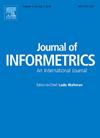科学论文隶属关系中的排名分布:不同形式的齐夫定律有和没有高阶逆参与比
IF 3.5
2区 管理学
Q2 COMPUTER SCIENCE, INTERDISCIPLINARY APPLICATIONS
引用次数: 0
摘要
尽管通常难以定义和参数化,但在一个日益相互联系的世界中,来自不同中心、不同国家或大洲的科学家之间的科学合作似乎是一个有趣而重要的问题。这些信息的一个自然来源是包含作者所属关系的科学论文。它们不允许确定作者的来源(至少目前是这样),但是它们可以用来显示单个国家在科学界的参与程度。通过分析一大批出版物,就有可能收集到覆盖各国的文献链及其作者所属机构的多样性,并在此基础上有可能显示出科学团队合作的最常见模式。由于在本文中,我们感兴趣的是一种更一般的统计方法,因此使用获得的链来计算一个指标(称为逆参与率),该指标表示各个国家参与分布的不同模式。我们表明,科学世界是世界上观察到的普遍规律的另一个例子,因为获得的逆参与率值的分布服从齐夫定律。本文章由计算机程序翻译,如有差异,请以英文原文为准。
Rank-based distributions in scientific papers affiliations: Different forms of Zipf's law with and without higher order inverse participation ratios
Although often difficult to define and parameterize, scientific collaboration between scientists from different centers and different countries or continents seems to be an interesting and important issue in an increasingly interconnected world. One natural source of such information is scientific papers that include the affiliations of the authors. They do not allow determining the origin of the authors (at least currently), but they can be used to show how large the participation of individual countries in the scientific world is. By analyzing a large set of publications, it is possible to collect chains covering countries and their multiplicity in the affiliations of the authors, and on this basis it is possible to show the most common patterns of collaborating scientific teams. Since in this article we are interested in a more general, statistical approach, the obtained chains are used to calculate an indicator (known as the inverse participation ratio) that expresses different patterns of the distribution of participation of individual countries. We show that the scientific world is another example of universal laws observed in the world because the obtained distribution of inverse participation ratio values obeys Zipf's law.
求助全文
通过发布文献求助,成功后即可免费获取论文全文。
去求助
来源期刊

Journal of Informetrics
Social Sciences-Library and Information Sciences
CiteScore
6.40
自引率
16.20%
发文量
95
期刊介绍:
Journal of Informetrics (JOI) publishes rigorous high-quality research on quantitative aspects of information science. The main focus of the journal is on topics in bibliometrics, scientometrics, webometrics, patentometrics, altmetrics and research evaluation. Contributions studying informetric problems using methods from other quantitative fields, such as mathematics, statistics, computer science, economics and econometrics, and network science, are especially encouraged. JOI publishes both theoretical and empirical work. In general, case studies, for instance a bibliometric analysis focusing on a specific research field or a specific country, are not considered suitable for publication in JOI, unless they contain innovative methodological elements.
 求助内容:
求助内容: 应助结果提醒方式:
应助结果提醒方式:


